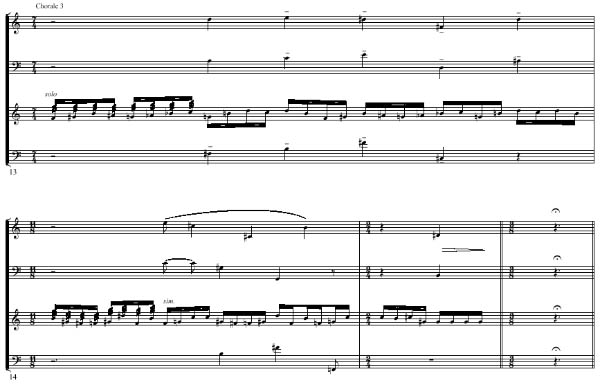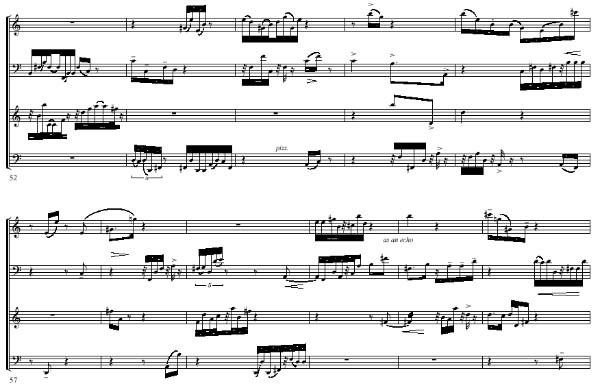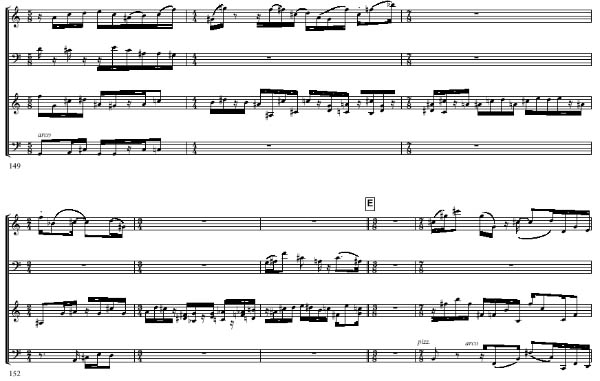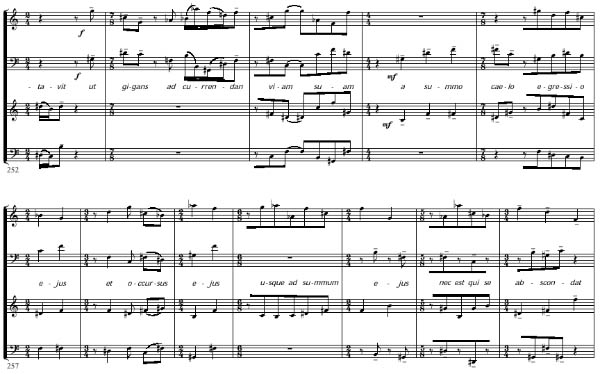Please note: some links on this page are in maintenance.
Explore two instrumental scores that represent important stages on the journey towards the integration of timbre with pitch and rhythm.
[Introduction]
Nigel Morgan has long sought to find a personal solution to developing
a robust relationship with the element of timbre as an equal partner with
pitch and rhythm in the making of musical works. Can musical timbre be
organised, be responsive to, and effect large-scale musical structuring?
Or will it always be just the outer layer of a musical message that serves
to clarify pitch and rhythm? For a composer who is fascinated by the idea
of instrumentation as a open and speculative area within musical composition
finding a way to integrate timbre into compositional thinking, yet leave
some freedom for variety and change in instrumental forces and timbral
colouring, has been a serious issue.
[Introduction]
Before starting the orchestral series of six concertos (Instrumentarium Novum) a number of works were written to explore and develop strategies and devices to control the organization of timbre. The main intention has been to integrate the play of timbre across a musical surface with the origination of pitch and rhythm.
There were a two key reference scores that became guides and sources of inspiration: Milton Babbitt’s
Composition for Four Instruments and Morton Feldman’s IXION. These compositions not only demonstrate elegant solutions to the large-scale structuring of timbre and orchestration, but show how the density and activity of musical events can be represented in novel ways.
Another important consideration in establishing a modus operandi for integrating timbre has been the desire to re-invent and re-establish the continuo at the heart of instrumental composition, particularly in orchestra music. Having a group of harmony, bass and percussion instruments able to reinforce and extend the harmonic and rhythmic content of melodic phrases makes it possible to jettison repetitious accompanying or background figures that define but usually restrict the musical texture. The main musical content then becomes a democratic play of melodic lines. This opens up possibilities for performers to explore the potential of those aspects of performance that can provide
emphasis, clarity and meaning to the musical argument.
Here are two scores – Seven Magical Preludes and Quatuor des Timbres – that represent important stages on the journey towards the integration of timbre.
[Introduction]
[Seven Magical Preludes]
. . . atque imaginibus magicis
Seven Magical Preludes – for Percussion Sextet

The Seven Magical Preludes were devised as an upbeat for a performance of the original version of Carl Orff’s popular choral work Carmina Burana. The instrumentation follows Orff’s own exactly, except in the use of the full compass of the tubular bells – Orff asks for just 3 pitches. If this is a logistical problem, a vibraphone may be substituted for the tubular bell part. In the Sixth Prelude, 2 players are required to play the single set of tubular bells.
The Seven Preludes should be played as a continuous whole. Dynamics, accents and tempo indications are a guide, no more. The music should be approached ‘in the spirit’ of Carmina Burana, like a sonic tableau acted out by six musicians. Stylised movements, gestures and other theatrical presentation are envisaged and welcomed.
The first performance of Seven Magical Preludes was given in June 2001 by six members of BBC NOW in a concert given in Bristol Cathedral by the Bristol Choral Society.
[Introduction]
[Seven Magical Preludes]

In the introduction to the published score
of Orff’s Carmina Burana Werner Thomas describes how the poems Orff
selected from the 13C Benediktbeuren manuscript are ‘brimful of portraits
– vignettes as it were, of the great and small world theatre. Only by
virtue of this characteristic could Orff – a surprising and strange
approach – ‘stage’ lyric poetry in which he gave independent existence
to the images inherent in the poems, let the figures emerge from them,
and through the music allow them to act in a choreography that was both
graphic and symbolic. The images are ‘imagines magicae’, in which reality
is magically transformed: Spring – Dance in the meadow – Drinking and
gaming in the tavern – The game of love in the sublimest form of the
late Middle Ages ‘Cours d’amours’- in the choreographed and mimed stage
action allow the core of the symbolic meaning to become visible’.
[Introduction]
[Seven Magical Preludes]
In these ‘magical preludes’ for the percussion ensemble Carl Orff himself selected for the version for 2 pianos and percussion, the music attempts a continuous sequence of images through engaging and extending the rhythms and colours possible through percussion alone. There is no use of direct quotation from Orff, only a consideration to steer the musical material toward a modal conclusion in the seventh prelude: to make, should the preludes be performed prior to Carmina Burana, a smooth transition into ‘O Fortunata’.

[Introduction]
[Seven Magical Preludes]
[Quatuor des Timbres]
Quatuor des Timbres – for an ensemble of mixed timbres
version for soprano sax in Bb, bass trombone, tuned percussion and violoncello
Quatuor des Timbres (A Quartet of Timbres) was written between 20 May and 17 June 2002. In this short period a number of major technical innovations developed which have laid the foundations for the series of orchestral music Instrumentarium Novum begun in 2003. The objective of Quatuor des Timbres was to investigate different and formal ways an ensemble of instruments of different timbres might interact with one another within particular musical situations.
The music looks backwards to devices from the Renaissance (vocal and instrumental setting of a Psalm text) and the Baroque (chorales); performance instructions are kept to a minimum, and any that are present should be considered as a guide, no more.
The music looks forward in unique ‘playful’ open-form structures that develop from algorithmic computation modeling the activity and density of sound within an ensemble of instruments across time.
[Introduction]
[Seven Magical Preludes]
[Quatuor des Timbres]
In the 2nd and 3rd movements two contemporary models are acknowledged: Milton Babbitt’s graphic notation applied to the initial structuring of his early Composition for Four Instruments; Morton Feldman’s score of IXION in which graphic structuring of activity is extended to include the density of sound attacks.


The quartet is devised for an ensemble of diverse or mixed timbres. In this published version an ensemble of soprano sax in Bb, bass trombone, violoncello and tuned percussion is imagined. There exists
a parallel version for flute, tenor saxophone in Bb, double bass and synthesiser realised for members of the BBC National Orchestra of Wales. For professional ensembles the composer is willing to undertake re-orchestrations or provide the basic data files to enable performers to undertake orchestrations themselves. More than four instruments may be scored.
In the rehearsals for the initial performances of this work musicians from the BBCNOW, although at first reluctant to devise their own dynamic schemes, articulations and tempos, brought to the work a wealth of ideas and invention: the flautist adopted oriental inflections (as well as using piccolo and alto flute), the sax player employed jazz timbres and ornaments, the bassist brought into play many rich timbral colours, and the keyboard player made extensive use of different voices, modulation and pitch bend.
The music is published in a performance score with appropriate transpositions. A set of individual parts is also available.
[Introduction]
[Seven Magical Preludes]
[Quatuor des Timbres]
Quatuor des Timbres I – Four Necessary Chorales

[Introduction]
[Seven Magical Preludes]
[Quatuor des Timbres]
Quatuor des Timbres II – Giuco delle Coppe (The Game of Pairs)

[Introduction]
[Seven Magical Preludes]
[Quatuor des Timbres]
Quatuor des Timbres III – Jeux Diurnes (Afternoon Games)

[Introduction]
[Seven Magical Preludes]
[Quatuor des Timbres]
Quatuor des Timbres IV – In Finem Psalmus David (Psalm IX)

Quatuor des Timbres – for an ensemble of mixed timbres
